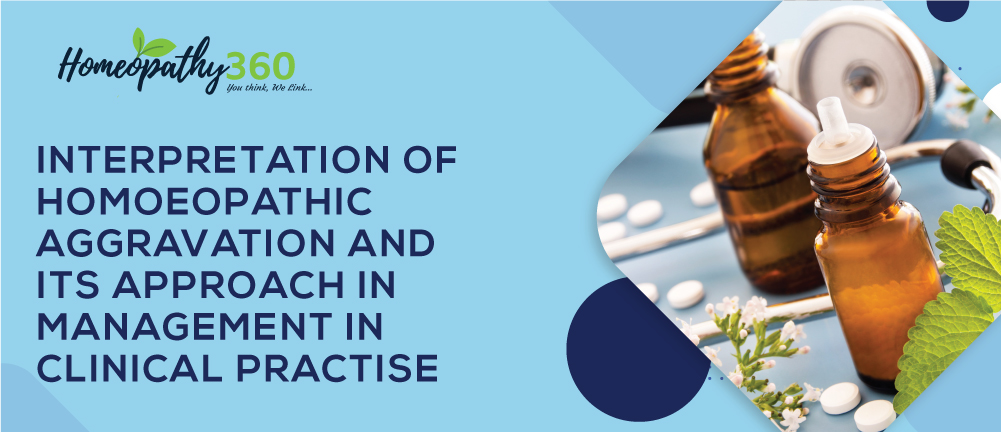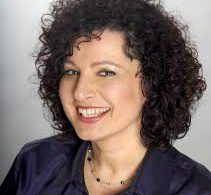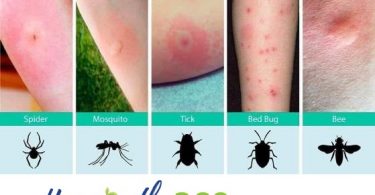
ABSTRACT: The following article describes about homoeopathic aggravation, reviews of Hahnemann’s contemporaries on it, some of the views of stalwarts, modern day concepts and its management in clinical practise.
KEYWORDS: Homoeopathic aggravation, rebound phenomena, management
ABBREVIATIONS: F.N.- Footnote, § – aphorism.
INTRODUCTION:
The word aggravation means, the act of increasing or the fact of being increased in gravity or seriousness.1 By “aggravation” is meant an increase or intensification of already existing symptoms by some appreciable circumstance or condition.2 In homoeopathic practise, one encounters three types of aggravation, i.e. homoeopathic, medicinal and disease aggravation. The medicinal disease very similar, but somewhat superior in strength, to the original disease is termed as homoeopathic aggravation.3
HISTORICAL BACKGROUND:
First hint- In Essay on a New Principle; Hahnemann says, “a somewhat too large dose of henbane is apt to cause, in its secondary action, great fearfulness.” 4
First instance- Actual occurrence of an aggravation was that of a pregnant woman who, in order to cure cramp in her leg, took five drops of the volatile oil of chamomile, whereby the cramp was vastly increased, and a number of other symptoms peculiar to the drug occurred.4
First distinct and decided case- A case of colicodynia mentioned by Hahnemann of a real homoeopathic aggravation, followed by a well-marked curative effect published in the year 1797 where Veratrum album was prescribed.4
HOMOEOPATHIC AGGRAVATION IN LIGHT OF ORGANON OF MEDICINE:
Idea of homoeopathic aggravation gradually evolved. Example, § 157 to 160 contains only one aphorism in the 1st edition and § 161 is not included in the 1st and 2nd edition, and in the 3rd, it appears as a supplementary paragraph between § 167 and 168.5
Homoeopathic aggravation was also observed by other physicians. Example, Lyson-, “The bark of elm cures most certainly those skin diseases which it increases at the beginning of its action”. (F.N. to § 160).
Occurrence of homoeopathic aggravation-
- Cases of acute character or of recent origin- 1st or 1st few hours. (§ 161)
- Long standing cases- First 6,8 or 10 days. (§ 161)
- Medicine selected in correct homoeopathic manner, acting well and usefully- by 8th or 10th day, for an hour or even half a day moderate homoeopathic aggravation takes place.6
- Very tedious ailments- homoeopathic aggravation do not occur before 24th or 30th day.6
- In 50 millesimal scale- increase of original symptoms of a chronic disease can appear only at the end of the treatment when the cure is almost or quite finished. (Schein-Symptome, §248, 6th edition).
In order to prevent the undesirable reactions of the vital energy, was wholly solved by new altered but perfect method. (§ 246 F.N. 6th edition)
Dose of homoeopathic remedy can never be prepared so small that it will not be stronger than natural disease and is capable of producing slight homoeopathic aggravation after ingestion. (§ 279). Hahnemann said that this should be a measurement of all homoeopathic medicines that it should be reduced to such an extent that it excites a scarcely observable homoeopathic aggravation after their ingestion. (§ 280).
Smallest dose produces very slight homoeopathic aggravation. (§ 282). Too large dose, especially in chronic diseases, produces so called homoeopathic aggravation. (§ 282 6th edition).
HAHNEMANN’S CONTEMPORARIES ON HOMOEOPATHIC AGGRAVATION:
Hahnemann says, when the usual customary symptoms are aggravated and show most prominently on the first days and again on some of the following days, but gradually less and less. This so called homoeopathic aggravation is a sign of an incipient cure, which may be expected with certainty.6
But the subject of aggravation was the topic of considerable discussion in Hahnemann’s own lifetime and amongst his early followers. These divergent views are as follows-4
| AUTHORS | FOR | AGAINST |
| SCHRON | He called idea of homoeopathic aggravation an “unfortunate dogma.” | |
| RUMMEL | He admits the occasional occurrence of the homoeopathic aggravation, considers it as the exception not the rule. | |
| KURTZ | He believes that the occurrence of homoeopathic aggravation is impossible if the remedy were perfectly homoeopathic. | |
| GROSS | He describes two types of aggravations- First is early and evanescent due to too small doses. Second is occurring later due to too large doses. | |
| HIRSCHEL | He denies that the homoeopathic aggravation is necessary for the cure. | |
| SCHMID | He asserts that if the dose be sufficiently large, no so called homoeopathic aggravation will occur, and that it is met with only when the dose is too small. | |
| SCHNEIDER | He called Hahnemann’s homoeopathic aggravation “a phantom.” He says homoeopathic aggravation is “a psychical effect of the homoeopathic theory;” in other words, fancy. | |
| KAMPFER | He admits the occurrence of homoeopathic aggravation. One is critical which is followed by amelioration. Other being non-critical in which no amelioration takes place. | |
| ROMANO | He is a firm believer of Hahnemannic homoeopathic aggravation. He thinks that he has discovered the touchstone for distinguishing disease and medicinal aggravation. He says that during the aggravation if the pulse is slower or not quicker than it is a medicinal aggravation. If quicker it is an exacerbation of disease. |
OPINIONS OF STALWARTS ON HOMOEOPATHIC AGGRAVATION:
J. T. KENT-
He says the aggravation is of two kinds; we may have an aggravation which is an aggravation of disease in which the patient is growing worse or we may have an aggravation of symptoms in which patient is growing better. The true homoeopathic aggravation, I say is when the symptoms is worse, but the patient says, “I feel better”.7 In acute disease we seldomly see anything like striking aggravation unless the acute disease has drawn near death’s door, or is very severe, unless it has lasted many days, and breaking down of blood and tissue is threatened, or has taken place. When the chronic disease has not ultimated itself in tissue changes, you may get no aggravation at all, unless, perhaps it be a very slight exacerbation of the symptoms.7
STUART CLOSE-
The “homoeopathic aggravation” or slight intensification of the symptoms which sometimes follows the administration of the curative remedy, is merely the reaction of the organism, previously perhaps inactive or acting improperly because of lowered susceptibility, as it responds to the gently stimulating action of the medicine.2
H. A. ROBERTS-There are two types of aggravation.8
The aggravation which is an aggravation of the disease condition, in which the patient grows worse.
There may be a very different type of aggravation in which the symptoms are worse, but the patient is growing better. He will say, “I feel better, doctor, but such-and-such symptoms are worse”.
R. E. DUDGEON-
He says that the homoeopathic aggravation of Hahnemann was a necessary deduction of his theoretical explanation of the mode in which the homoeopathic medicines acted, viz., by the stronger expelling the weaker. It is part and parcel of this theory, and nothing more.4
J. N. KANJILAL-
In treatment of chronic cases, especially very chronic ones, it is my oft repeated experience that one dose of similimum is followed by not only one set of homoeopathic aggravation followed by amelioration, but by a series of such sets of aggravations and ameliorations with gradually lesser and lesser and intensity and at longer and longer intervals.9
MODERN DAY CONCEPTS IN RELATION TO HOMOEOPATHIC AGGRAVATION:
P. Schmidt says- what we have called for the last 150 years homoeopathic aggravation and what modern classical medicine has recently detected and called “rebound phenomena”.10
Homoeopathic aggravation can be observed in fields where the similia principle is used like vaccine therapy and treatment of allergic conditions.5
MANAGEMENT IN CLINICAL PRACTISE:
Why the Responses and What to do?
Kent has thrown a flood of light on these questions in “prognosis after observing the action of the remedy” and also by H. A. Roberts in “remedy reaction”.
So, keeping these two and also “follow up of the case” by Diwan Harish Chand, the following management table has been given-7-9
| Nature of reaction | Cause of reaction | What to do? |
| Amelioration with very slight aggravation or no aggravation with recovery of patient. | Remedy is curative and potency exactly fitted the case. No organic diseases present. | Do not interfere till symptoms return. |
| Aggravation is quick, short and strong followed by rapid improvement. (in acute: agg in first few hours. In chronic: first few days.) | Remedy and potency both correct. Reaction is vigorous. No tendency to structural change in vital organs, though may be in parts not essential to life. | Best result will follow such initial homoeopathic aggravation. Hands off till symptoms returns. |
| Aggravation is long (may be weeks) and severe but final and slow improvement. | Case was almost incurable, or borderline case, vitality being low. The physician has got him before the trouble has gone so far, as organic changes have just threatening to come. The potency was too high. | All will be well if remedy is not repeated too soon. Wait till the patient has sufficient strength to react to another dose. |
| Prolong aggravation with slow decline of patient’s strength. | Marked organic changes present. Potency is too high for the feeble reaction of the patient, and the remedy was too late. | Try to palliate with short acting remedies in lower potencies. Do not give a deep acting remedy when organic disease is present. |
| A severe aggravation in curable cases and sound vitality- caused unnecessarily by high potency. | Too high potency say, CM was given. Or Too low a potency given repeatedly. | Even during aggravation, patient feels better as it is only similar medicinal agg and not of the disease. Aggravation will pass off if left alone. If aggravation is severe, antidote it and follow with a medium potency, limited doses. |
| To avoid agg. | In a very feeble vitality. Strong vitality but marked tissue changes. Excited and sensitive patient. Great sensitiveness. | Give a single dose of a potency and watch the minutest sign for direction of symptoms. Try lower or medium potency, or the 50 millesimal potencies according to case. In 50 millesimal potency, a teaspoonful of this solution may be put in a 2nd glass of water, thoroughly stirred and teaspoonful doses or more be given. 3rd or 4th glass, similarly prepared, may be necessary. (§ 248 6th edition F.N) |
CONCLUSION:
The topic of homoeopathic aggravation has always been debatable. Right from Hahnemann’s time till the present day, it is a great topic of discussion whether homoeopathic aggravation exists or not. Some authors say that it is merely a theory while others say that it is necessary for cure. Hahnemann himself has asserted that for a cure to occur homoeopathic aggravation should take place. If there occurs homoeopathic aggravation, one has to deal it wisely as per the instructions from our literatures and one’s experiences.
REFERENCES:
- The New Shorter Oxford English Dictionary. New York: Oxford University Press Inc.; 1993. 40 p.
- Close S. The Genius of Homoeopathy Lectures and Essays on Homoeopathic Philosophy. New Delhi: B Jain Publishers (P) Ltd; 10th impression 2012. p. 152, 76
- Hahnemann S. Organon of Medicine. 5th & 6th edition. New Delhi: B Jain Publishers (P) Ltd; 5th impression 2009.
- Chand DH. A Compendium of lectures on Homoeopathy. New Delhi: National Homoeopathic Pharmacy; 1995.
- Hahnemann S. The Chronic Diseases Their Peculiar Nature and Their Homoeopathic cure Vol 1. New Delhi: B Jain Publishers (P) Ltd; 14th impression 2014. p. 122, 119-20
- Kent JT. Lectures on Homoeopathic Philosophy. Low price edition 2002. New Delhi: B Jain Publishers (P) Ltd; 12th impression 2013. p. 225, 215-16, 224-234
- Roberts HA. The Principles and Art of Cure by Homoeopathy. 3rd edition 2005. New Delhi: B Jain Publishers (P) Ltd; 9th impression 2013. p. 120, 119-130
- Gunavante SM. Introduction to Homoeopathic Prescribing. 4th ed. New Delhi: B Jain Publishers (P) Ltd; 1990. p. 162,165-70.
- Schmidt P. The Art of Case Taking and Interrogation Including Other Treasure Works. Noida UP: B Jain Publishers (P) Ltd; 3rd impression 2018. p. 132
About the authors:
- Prof. (Dr) Subhasish Ganguly- H.O.D. Dept. of Organon of Medicine, D. N. De Homoeopathic Medical College & Hospital
- Dr Ranjita Gupta- PGT Dept. of Organon of Medicine, D. N. De Homoeopathic Medical College & Hospital
- Dr Sujeet Lal- PGT Dept. of Materia Medica, D. N. De Homoeopathic Medical College & Hospital





